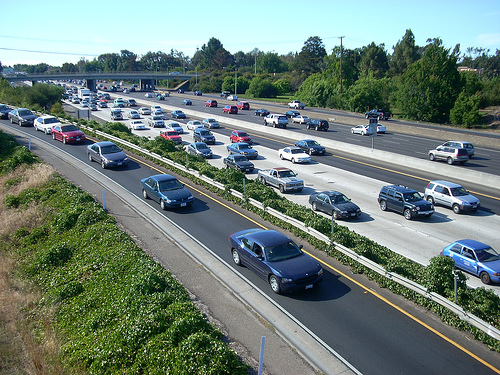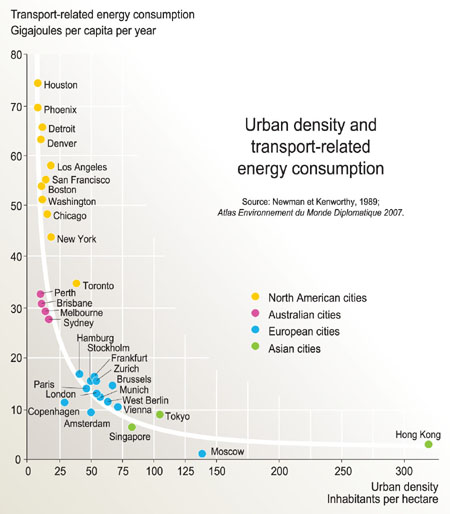Cross-posted from PubliCola.
In response to last week’s post about how cars cause significant greenhouse gas emissions in addition to what comes out of the tailpipe, some commenters contended that even so, car-dependency is not a problem because cars can be as energy-efficient per passenger-mile as buses and trains.
But that perspective is classic “can’t see the forest for the trees,” because vehicle efficiency is just one piece of the puzzle that leads to an efficient urban transportation system.
The sexy graph below tells the story (click it to see an enlarged version):
For the U.S. we see that in general, cities with higher density and more extensive transit service use less energy per capita for transportation, with New York consuming the least. Seattle would land a bit to the left of Los Angeles on the graph. (Keep in mind that greenhouse gas emissions are typically about proportional to energy use.)
But what’s truly amazing is the difference between the U.S. and Europe. On average the European cities use about one third of the energy used by New York, the most transportation-efficient city in the U.S. How is that possible?
Socioeconomics likely explains part of it, since it is a nearly universal truth that energy use increases with personal income. It’s worth noting, however, that even though average incomes in the U.S. are higher than those in most European countries, European city-dwellers enjoy a quality of life that is at least on par with U.S. cities.
And part of it the difference is due to the relatively small, efficient cars Europeans tend to drive.
But the critical ingredient of Europe’s high-efficiency urban transportation systems is a synergistic combination of extensive, high-quality transit, and compact, mixed-use development patterns.
These factors are mutually reinforcing: Population density and a mix of uses enable shorter trips and allows transit to operate efficiently; and transit stations create spatial catalysts around which compact development can be focused.
When transit serves high density areas it tends to run closer to capacity, thereby reducing energy consumed per passenger. When trips are shorter, they require less energy if made by motor vehicle, but are also more likely to be made by foot or bike.
Furthermore, when there are attractive alternatives to a car, less people own them, which has the added benefit of reducing the non-trivial energy use and greenhouse gas emissions associated with manufacture, maintenance, and infrastructure, as discussed here. If those factors were included on the graph above, the difference between European and U.S. cities would become even more pronounced.
The end result is a balanced, equitable, energy-efficient urban transportation system. And this is not just hopeful speculation. The proof is on the ground in cities all over the world.
In the U.S, the absurd amount of car-dependent sprawl we have built is a major impediment to creating the kind of compact, walkable, transit-rich communities that will reduce our transportation system’s energy consumption over the long term. But here in the Puget Sound region, because we are growing, we have a unique opportunity to make progress. The region’s population is projected to grow by 40 percent over the next three decades. If we hope to create a region that will prosper in the face of future challenges, we must do everything possible to accommodate this growth with compact development and aggressive transit investments.





